Country Iran Land area 440 ha (1,100 acres) Opened 1983 | Size of harbor 480 ha (1,200 acres) Annual cargo tonnage 1.905 billion kg | |
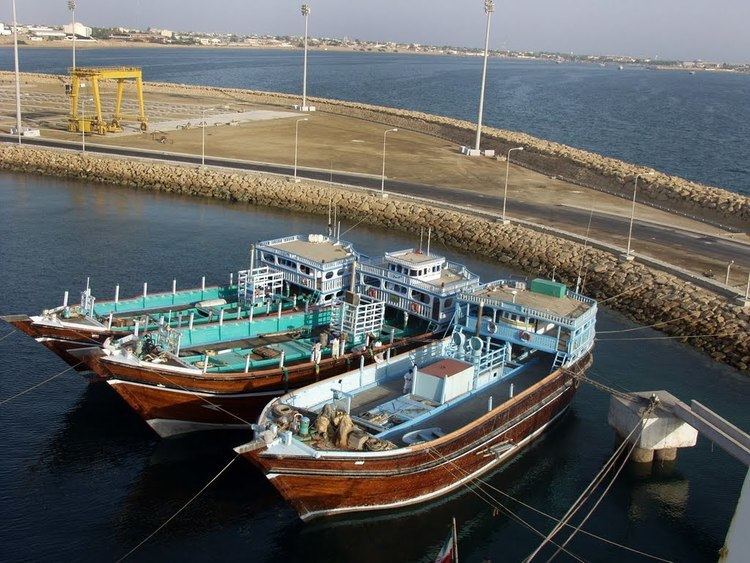 | ||
Owned by Ports and Maritime Organization | ||
Modi magic chabahar port expected to open in a month gwadar to loose significance
Chabahar Port (Persian: بندر چابهار) is a seaport in Chabahar located in southeastern Iran, on the Gulf of Oman. It serves as Iran's only oceanic port, and consists of two separate ports named Shahid Kalantari and Shahid Beheshti, each of which have five berths.
Contents
- Modi magic chabahar port expected to open in a month gwadar to loose significance
- Location
- History
- Irans international strategy
- Iran India partnership
- May 2016 Agreement between India Iran and Afghanistan
- ChabaharZahedan Railway
- Private sector investments
- Strategic implications
- Security issues
- References
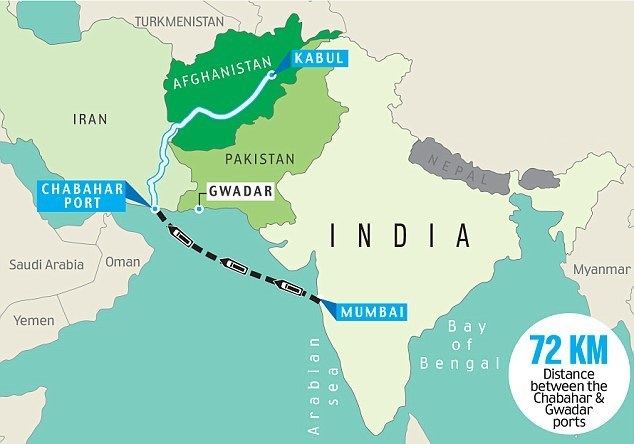
Development of the port was first proposed in 1973 by the last Shah of Iran, though development was delayed by the 1979 Iranian Revolution. The first phase of the port was opened in 1983 during the Iran–Iraq War as Iran began shifting seaborne trade east towards the Pakistani border in order to decrease dependency on ports in the Persian Gulf which were vulnerable to attack by the Iraqi Air Force.
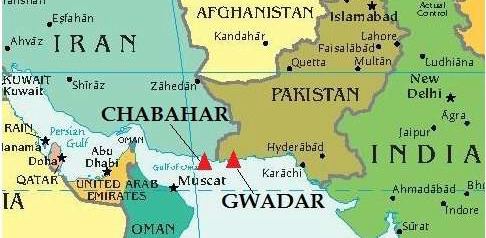
India and Iran first agreed to plans to further develop Shahid Beheshti port in 2003, but did not do so on account of sanctions against Iran. As of 2016, the port has ten berths. In May 2016, India and Iran signed a bilateral agreement in which India would refurbish one of the berths at Shahid Beheshti port, and reconstruct a 600 meter long container handling facility at the port. The port is intended to provide an alternative for trade between India and Afghanistan. This port is 800 kilometers closer to Afghanistan than Pakistan's Karachi port. The port handled 2.1 million tons of cargo in 2015, which is planned to be upgraded to handle 8.5 million tons by 2016, and to 86 million tons in the future.
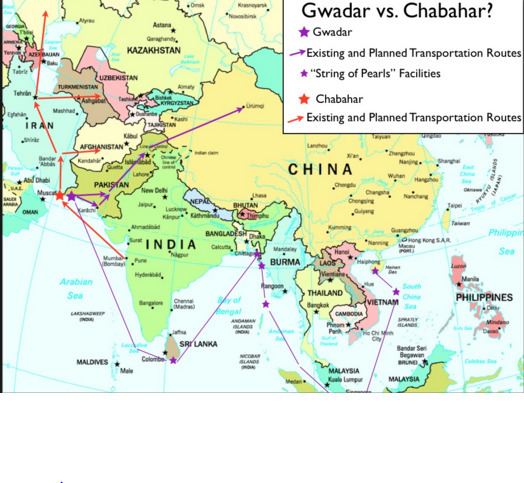
As of February 2017, the project remains delayed as Indian funds had not been released for the project, as the governments of Iran and India blame one other for delays. India maintains that Iran has not submitted a proposal for release of the funds, while Iran states that the Indian side has delayed the project. The election of Donald Trump as President of the United States may further hinder the project, as Trump advocates a hard-line stance against Iran.
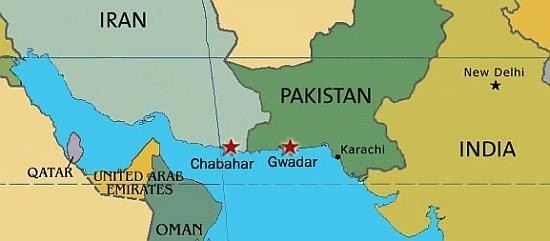
Location
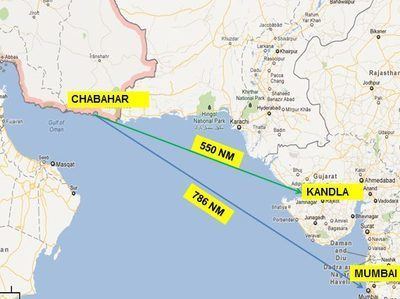
The port of Chabahar is located on the Makran coast of Sistan and Baluchistan Province, next to the Gulf of Oman and at the mouth of Strait of Hormuz. It is the only Iranian port with direct access to the Indian Ocean. Being close to Afghanistan and the Central Asian countries of Turkmenistan, Uzbekistan etc., it has been termed the "Golden Gate" to these land-locked countries.

Chabahar is 700 km away from Zahedan, the capital of the Sistan and Baluchistan province, 950 km away from Milak, the closest city to the Afghan border, and 1827 km away from Sarakhs on the Turkmen border.
The marine distance to Dubai is 353 nautical miles (nm), Karachi in Pakistan is 455 nm, and Mumbai in India is 843 nm. Pakistan's Chinese-funded deep sea port at Gwadar is also on the Makran coast, at a distance of mere 72 km. Gwadar also claims to provide access to Central Asia, and comparisons between the two ports are frequently made by analysts.
Because 90 percent of Iran's population is concentrated in the western part of the country, the eastern part is relatively less developed. Iran is intending to change that by the development around Chabahar port, with a free trade zone, and road and rail links between Chabahar and Central Asia. Its plan is to use Chabahar port as the gateway to Central Asia and maintain the Bandar Abbas port, which currently handles 85% of Iran's seaborne trade, as a hub for trade with Russia and Europe.
The highly congested Bandar Abbas port is not a deep water port and cannot handle the 250,000 ton ocean-going cargo ships. At present, such ships dock in the United Arab Emirates (UAE) and the cargo is transferred to smaller 100,000 ton ships for onward shipment to Iran. This makes Iran dependent on the UAE for shipments and represents a loss of revenue. Unlike Bandar Abbas, Chabahar has the ability to handle standard cargo ships.
History
A former port named Tis in Chabahar's neighborhood dates back to 2500 BC, known in Alexander the Great's conquests. Alberuni wrote that the sea coast of India commences with Tis. The Portuguese forces under Afonso de Albuquerque gained control of Chabahar and Tis, staying there until 1621. The British, and later the Portuguese in the 17th century entered this region.
Modern Chabahar dates back to around 1970, when it was declared a municipality and large port projects were started by order of Mohammad Reza Pahlavi, the Shah of Iran. Shah planned to construct a $600 million naval base at Chabahar, mostly employing American companies as contractors. The American naval officials held talks with their Iranian counterparts on securing an "option" to operate out of Chabahar in the event of an emergency. However, in 1977, Shah got strapped for cash, caught in a tug of war between the OPEC and the western oil companies over the price of oil, and the start of construction of Chabahar base was postponed. Soon afterwards, the Shah was overthrown in the Iranian revolution.
After the 1979 revolution the foreign companies left the projects and Iranian public companies linked to the Ministry of Jahad-e Sazandegi (or jihad for construction) took them over. The Iran-Iraq war (1980–1988) caused Chabahar to gain in logistical and strategic importance. War brought insecurity to the Strait of Hormuz and ships were unable to enter the Persian Gulf. Accordingly, Chabahar became a major port during the war.
The Chabahar port actually contains two separate ports called Shahid Kalantari and Shahid Beheshti. Between 1982 and 1983, Iran constructed four 45 meter berths at Shahid Kalantari and four 150 meter berths at Shahid Beheshti. Two larger berths, 235 and 265 meters long, were constructed in 1997 and 2004 respectively.
Iran's international strategy
Consistent with its desire to be seen as a significant regional player, Iran has taken the initiative to engage with all the neighbouring countries to enhance the transit potential of Chabahar. It has signed a Memorandum of Understanding (MoU) with Afghanistan and Tajikistan on the construction of railway lines, water pipelines and energy transmission lines. It has been keen to extend the Khvaf-Herat rail line to connect to the railways of Central Asia, Turkey, and Europe. It has entered into an agreement with Oman, Qatar, Turkmenistan and Uzbekistan to establish a transport corridor between these countries. It is also a key partner in the International North-South Transport Corridor (INSTC) along with Russia, Ukraine, Turkey, Oman, Syria, India and the Central Asian countries, which aims to connect South and Central Asian countries to Northern Europe via Iran and Russia. Specifically with respect to Chabahar, Iran has envisioned it as a key port in linking India with Afghanistan and Central Asian countries. Initiatives in this regard include a roadway from Chabahar to Milak on the Afghanistan border, Chabahar-Faraj-Bam railway, Chabahar-Zahedan-Mashhad rail link, which will be further extended to Herat and Mazar-e-Sharif in Afghanistan and Termez in Uzbekistan.
Iran-India partnership
During the 1990s Iran and India, along with Russia, collaborated in backing the Northern Alliance in Afghanistan against the Pakistan-backed Taliban. At this time, Iran invited India to develop the Chabahar port to obtain ready access to Afghanistan. In 1997, a trilateral agreement was signed with Turkmenistan to expand trade into Central Asia and, in 2000, another agreement with Russia to provide seamless transport between India and Europe via an International North-South Transport Corridor.
After the September 11 attacks and the American presence in Afghanistan, India, Iran and Afghanistan got together in January 2003, agreeing on a joint development of transportation links to Afghanistan. India agreed to expand the Chabahar port and to lay a railway track between Chabahar and Zaranj. Iran has completed 70 percent of the first phase of the Chabahar project at a cost of $340 million. India has spent $134 million during 2005–2009 to construct a road from Delaram in Afghanistan to Zaranj at the Iran-Afghanistan border. Iran has also built a roadway between Milak, close to Zaranj, and Chabahar passing through Zahedan and Iranshahr. Through Milak, Zaranj and Deleram, connectivity has been established to the Afghan `garland road', which connects the major Afghan cities Herat, Kandahar, Kabul and Mazar-e-Sharif. In March 2012, ships from India docked at Chabahar carrying 100,000 tonnes of wheat under humanitarian aid to Afghanistan. The Afghan businesses have begun to shift from the Karachi port to Chabahar port for transit.
However, without further development of the Chabahar port, these road links would remain underutilized. Despite intentions, India's involvement in the infrastructure development within Iran has been minimal, possibly due to the western pressure to apply sanctions. Iran is also believed to have a shown a preference for Iranian contractors instead of Indians. The initiative was restarted in August 2012 in a trilateral meeting on the sidelines of a Non-Aligned Summit.
May 2016 Agreement between India, Iran, and Afghanistan
In May 2016, India signed a series of twelve memorandums of understanding which centered upon the Port of Chabahar.
The trilateral transit agreement signed by India, Iran and Afghanistan allows Indian goods to reach Afghanistan through Iran. It links ports in the western coast of India to the Chabahar port and covers the road and rail links between Chabahar and the Afghan border.
The bilateral agreement between India and Iran gives India the right to develop two berths of the Chabahar port as agreed in 2015 and allows them to be operated for 10 years by India Ports Global, a joint venture between Jawaharlal Nehru Port Trust and Kandla Port Trust, in partnership with Iran's Aria Banader. India Ports Global has guaranteed handling of 30,000 TEUs by the third year of operations, and aims to eventually handle 250,000 TEUs.
The berths will be developed at a cost of $85 million over the course of 18 months. Under the agreement, India Ports Global will refurbish a 640 meter long container handling facility, and reconstruct a 600 meter long container handling facility at the port. India Ports Global will modernize ancillary infrastructure by installing four rail-mounted gantry cranes, sixteen rubber-tire gantry cranes, two reach stackers, two empty handlers, and six mobile harbor cranes. Upon completion of upgrade works agreed to in the May 2016 agreements, Chabahar's capacity will be increased to 8 million tons from the current 2.5 million ton capacity.
The investment is supplemented with a $150 million credit line to Iran through the Exim Bank of India. India has also offered to supply $400 million worth of steel towards the construction of a rail link between Chahbahar and Zahedan. Indian commitments to Iranian infrastructure could total $635 million as per the twelve memoranda of understanding signed in May 2016.
Iran's ambassador to Pakistan, Mehdi Honerdoost stated that Pakistan and China had both been invited to contribute to the project before India, but neither China nor Pakistan had expressed interest in joining.
Chabahar–Zahedan Railway
In May 2016, a memorandum of understanding was also signed for financing of the planned Chabahar–Zahedan railway, as part of North–South Transport Corridor, by Indian Railway's public sector unit Ircon International.
India has offered to supply approximately $400 million worth of steel towards the construction of this railway, while India has also offered to finance construction of the Chabahar to Zahedan rail line at a cost of $1.6 billion.
Chabahar's connection to the country's railway plan is under study and consideration. A rail link between Chabahar ane Zahedan, when completed, can connect Chabahar to the Kerman–Zahedan railway and further to the Trans-Iranian Railway.
Private sector investments
India's minister of Road Transport and Highways Nitin Gadkari also stated that Indian companies could potentially invest over ₹1 lakh crore (US$15 billion) in the Chabahar Special Economic zone. He however stated that potential investments would depend on whether Iran would be willing to supply Indian projects with natural gas at tariffs substantially lower than those offered by Iran.
Strategic implications
American policy analyst Rorry Daniels has characterized both the Indian investment in Chabahar and the Chinese investment in Gwadar as generating perceptions of "strategic encirclement". According to her, China fears encirclement by the US, India by China, and Pakistan by India. All of these encirclements are seen by the respective countries as "containment strategies", which they attempt to break out of. Indian news commenter Shishir Gupta described India's Chabahar Port deal as "a counter to the China-Pakistan Economic Corridor," as it has "broken through the strategic encirclement by China and Pakistan."
Scholar Neil Padukone however disagrees that India has a goal of encircling Pakistan. India needs access to iron from Afghanistan's Hajigak mine and other natural resources from the Central Asian countries of Kazakhstan, Turkmenistan, and Uzbekistan, which is made possible by the Chabahar port. But, in the long run, the pipeline-to-road-to-rail-to-sea-to-road shipment costs through Chabahar should be circumvented by direct transit through Pakistan. So far, Pakistan has been reluctant to provide such access. The US State Department does not currently see military cooperation between Iran and India as part of the Chabahar project, although it has cautioned India to remain within the legal parameters with respect to collaboration with Iran. The US also sees the Indian presence in greater Central Asia beneficial for spreading the soft power of democratic and friendly regimes. India hopes to see the Western countries use the Chabahar route to link to Afghanistan and reduce their dependence on Pakistan. Comments in the Chinese Press have indicated that China is unlikely to see India's efforts as strategic competition and that India's contribution to the infrastructure development in Central Asia will also benefit Chinese multinational corporations.
Padukone agrees that India has need for establishing a "naval counterweight" to China's presence in Gwadar, as India sees the Gwadar Port as a manifestation of a strong China–Pakistan alliance that seeks to choke Indian investments in the Indian Ocean region. Scholar Christophe Jaffrelot states that Gwadar gives the Chinese a key listening post to monitor US and Indian naval activity in the Persian Gulf as well as a dual-use civil-military base for Chinese ships and submarines. India perceive a direct threat and its response has been to help build the Chabahar port.
Iran has stated that Chabahar is not a rival to Pakistan's Gwadar and invited Pakistan to join in its development. Pakistani analysts have endorsed the view, stating that Gwadar has an advantage by being a deep sea port and the expansion of Chabahar would in fact expand trade through Gwadar. Larger vessels that cannot dock at Chabahar could dock at Gwadar and the cargo transshipped to Chabahar. Pakistan's foreign policy advisor Sartaj Aziz has signalled that Pakistan may link the Gwadar port to Chabahar.
However, Pakistani military commentators have characterised the alliance between India, Iran, and Afghanistan as a "security threat to Pakistan", and it had "ominous and far-reaching implications" to the region. Segments of the Pakistani press bemoaned the country's increasing "isolationism".
Security issues
Chronic instability in Afghanistan may limit usefulness of Chabahar as a conduit to Afghanistan and Central Asia. Road networks between Chabahar and Afghanistan rely upon connections to the Afghan Ring Road. In August 2016, insurgent activity by Afghanistan's Taliban militant group forced closure of the Ring Road between Kandahar and Helmand Province.
Iran's Sistan and Baluchestan Province, site of Chabahar port, is also the stage for insurgent activity by the insurgent group Jundallah, which claims to be fighting for the rights of Sunni Muslims, and the local ethnic Baloch. In 2010, Jundallah militants dispatched a suicide bomber to a Shi'ite mosque in Chabahar, killing 38 people.
In addition to Jundallah, Iran's Sistan and Baluchestan Province is also site for insurgent activity by the Salafi jihadist group, Jaish ul-Adl, which has also been responsible for acts of terror against Iranian civilians and military personnel.
